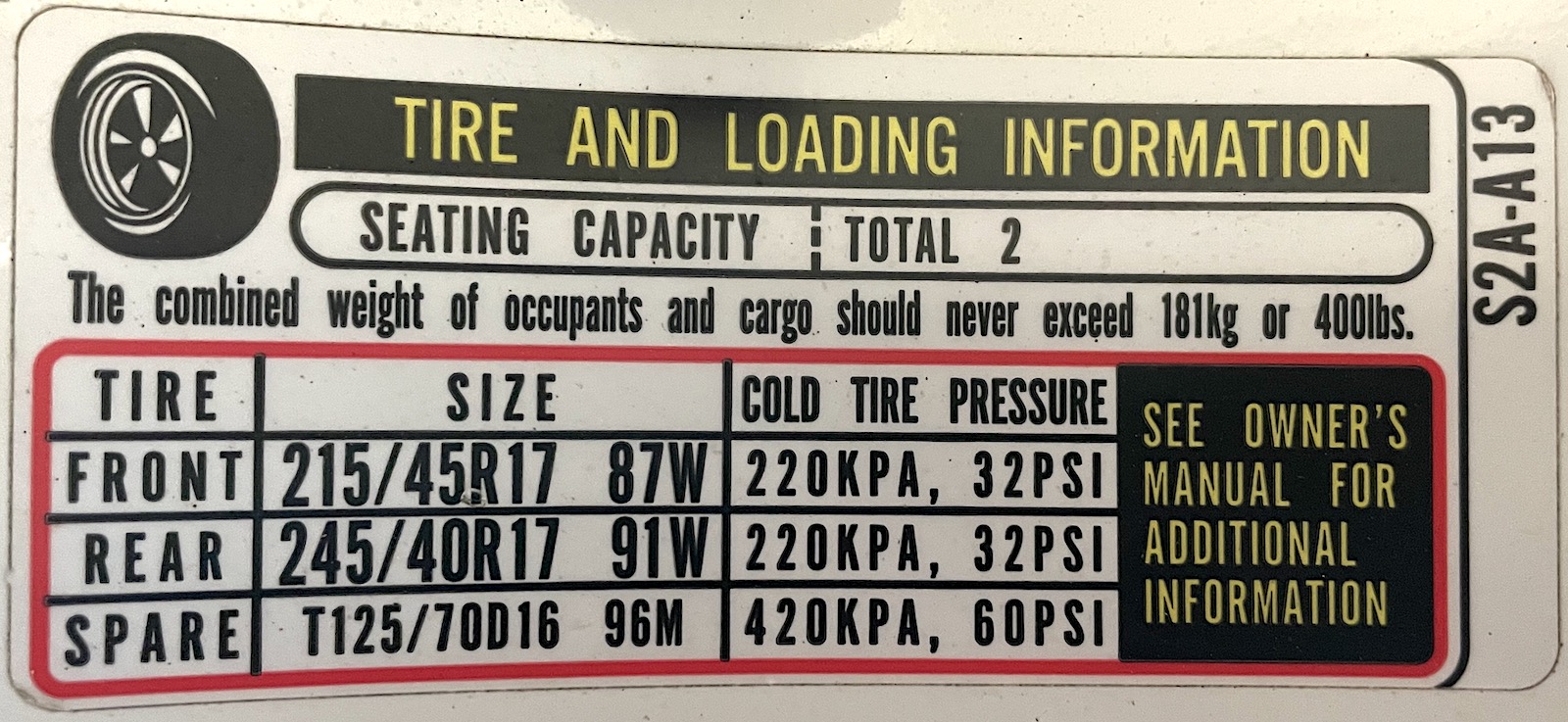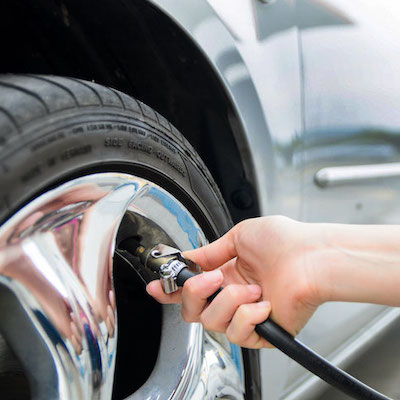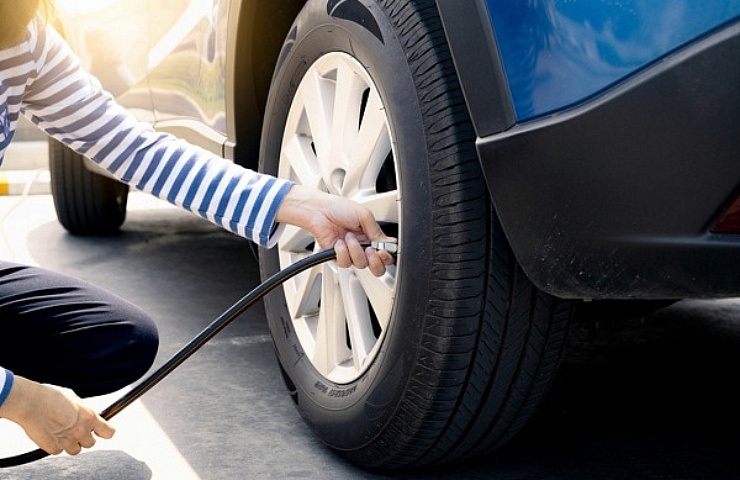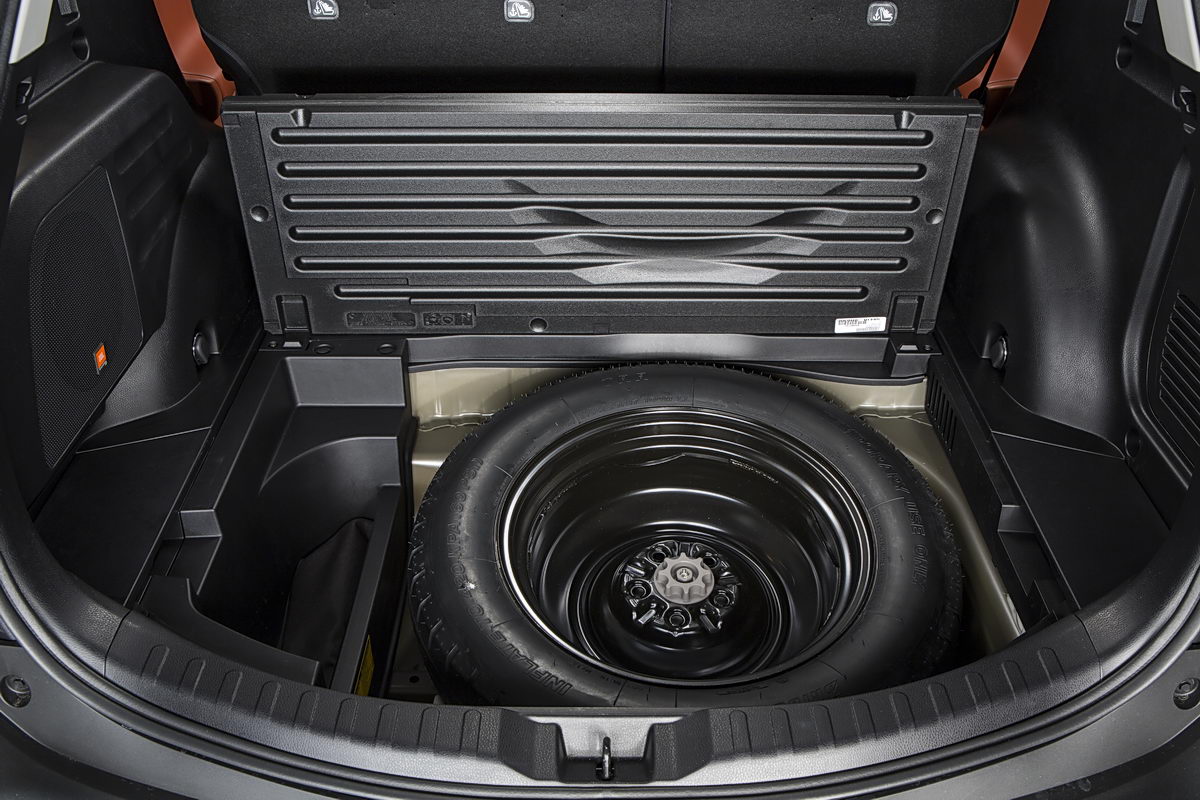Contents
A safe ride depends on keeping the right amount of air in your tires. If your tire pressure is low, you need to put more air in them to avoid a dangerous situation.
Shop now for tire pressure gaugesHow Much Air to Put in Tires
Automotive tires are meant to hold a specific amount of air pressure. For example, most passenger car tires are intended to be inflated to between 32 and 35 pounds per square inch (psi). However, this figure differs based on the type of vehicle you drive and its tires.

The Honda S2000 has staggered tires, but uses the same inflation pressure for both front and rear.
There are two places to find this recommendation for your tires:
- The sticker on the driver’s side door jamb
- The owner’s manual
Many people use the figure on the tire’s sidewall as the recommended pressure. This number is the maximum amount of air it’s meant to hold before a blowout could occur. Do not inflate your tires to match this number.
Shop now for portable tire inflatorsThere are two different ways you can fill up the tires. While the procedures are the same, one involves using a pump at a gas station, and the other relies on your home compressor or inflator.
How to Put Air in Tires at a Gas Station
If your vehicle has a tire-pressure monitoring system (TPMS) and its light comes on while driving, you don’t want to wait until you get home to put air in the tires. Instead, pull into the nearest gas station with an air pump.

- Unscrew the valve cap. Put it in a safe location so you don’t lose it.
- Connect the tire chuck to the valve. Tire air chucks, which connect to the stem or hose of a tire gauge, allow the air to flow freely.
- Press firmly on the tip as it connects with the valve stem. You should hear the air entering the tire. If it sounds like it’s leaking out, double-check your connection.
- Check the air pressure with a gauge. Continue filling until you reach the recommended pressure.
- Screw the cap back on.
- Follow the same procedure for other tires that are low.
Make sure you don’t overfill the tire. If you accidentally overfill it, release some air with your fingernail or a pen tip. Then, push gently on the metal part inside the valve center. Recheck the pressures.
Before you get back on the road, make a quick visual inspection. Check these parts of the tire:
- Tread. Look for nails or objects lodged into the rubber.
- Sidewall. Check for bulges, cuts, or anything unusual.
If you notice something wrong with the tires, you should have them checked by a professional tire installer immediately.
How to Put Air in Tires With a Compressor
Ideally, you can add air at home, when the tires are cool. However, whether you use an air compressor with a tire chuck or a portable tire inflator, the steps are similar to inflating tires at a gas station.
- Unscrew the valve cap. Put it in a safe location so you don’t lose it.
- Connect the nozzle of your compressor or inflator to the valve.
- Set the compressor or inflator to the appropriate level. With a compressor, you need a tire chuck to connect to the valve stem.
- Press firmly on the tip as it connects with the valve stem. You should hear the air entering the tire. If it sounds like it’s leaking out, double-check your connection.
- Check air pressure with a gauge. Continue filling until you reach the recommended pressure.
- Screw the cap back on.
- Follow the same procedure for any other tires that are low.
Again, you don’t want to over-inflate the tires. Plus, you should perform the same inspection listed above before you drive again.
How to Put Air in a Spare Tire
Don’t forget the importance of having air in your spare tire. If you get a flat tire, you want a functional spare tire.
Here are the steps needed to fill up your spare.
- Remove the spare from the vehicle. Many are located in the trunk, but some are under the car.
- Remove the valve cap and put it in a safe location.
- Press firmly on the tip as it connects with the valve stem. You should hear the air entering the tire. If it sounds like it’s leaking out, double-check your connection.
- Check air pressure with a gauge. Continue filling until you reach the recommended pressure.
- Screw the cap back on.
- Secure the spare tire in its original location.
We recommend checking the spare tire air pressure whenever you examine the others.
Should You Put Air in Warm or Cold Tires?
You want to fill your car tires when they are cold. However, if the tires are low and already warm, you have no choice but to fill them.
Vehicle manufacturers specify the correct psi assuming the tires are cold. For every 10 degrees Fahrenheit, the temperature rises, and the psi increases by one.
Tires are “cold” when the vehicle hasn’t been used for three hours or longer. You can also check the psi if the car was only driven for a mile or less at moderate speeds.
If you must fill the tire while it’s warm, remember to recheck it after the car has been parked for several hours. Then, fill it up again if needed.
Shop now for valve capsAlso, it’s essential to check the tire pressure every month. We also recommend checking tire pressures any time that the temperature radically changes.
Can You Put Air in Tires With Nitrogen?
Popular tire shops might offer to put nitrogen in car tires these days. Let’s look at a few of the pros and cons of using nitrogen, so you can decide what’s best for you.
Pros of Filling Tires With Nitrogen
- Larger molecules make it harder to escape through the tire liner
- Tire loses less pressure over time
- Lack of moisture creates more stable pressure
- Less oxidation occurs, protecting the wheel finish and TPMS sensors
- Better fuel economy
- Nitrogen is better for the environment
Cons of Filling Tires With Nitrogen
- It needs to be purged if regular compressed air is added
- Still requires maintenance
- More expensive when it’s not offered for free
Is It Free to Put Air in Tires?
Some gas stations offer air stations for free. For example, California law mandates free compressed air for all paying gas station customers. The service stations must also provide free water for automotive use. Connecticut has a similar regulation that requires free air pump access, but you don’t need to be a paying customer for this service.
If you live outside Connecticut and California, there are still ways to get free air for the tires. Here are a few locations offering free compressed air.
- Costco
- Discount Tire
- Firestone Complete Auto Care
- Goodyear Auto Service
- Just Tires
- NTB
- Sam’s Club
Some auto shops will fill your tires. There are even some locations that offer nitrogen at no extra charge.
Wherever you get the air, make sure you check the tire pressure with a gauge that’s reliable and accurate. Riding on tires with the wrong amount of air can lead to tread or sidewall damage, uneven wear, and reduced safety.
Shop now for portable tire inflators






